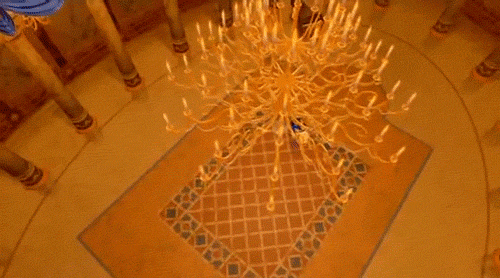'Beauty and the Beast' Classic Ballroom Scene: Inside Disney's First Proper Dance With CG

The love story at the heart of Disney’s animated classic, Beauty and the Beast, may be a tale as old as time, but back in 1991 the studio’s animators required up-to-the-minute technology to properly tell it. One of the movie’s timeless sequences — the ballroom dance number where Belle and the Beast share their first waltz while Angela Lansbury‘s Mrs. Potts serenades them — wouldn’t have been possible without the then-emerging tools of computer generated animation. That brief sequence, just a little over two minutes, put Disney on the path that leads directly to the new Beauty and the Beast, where live action and state of the art CGI-imagery co-exist side by side from opening scene to closing credits.
Beauty and the Beast wasn’t the first Disney cartoon to nudge the studio away from its hand-drawn tradition. The year before Beauty’s release, the Mouse House used The Rescuers Down Under, a belated sequel to Disney’s 1977 animated feature, as a proving ground for a new digital animation process being developed by a small computer graphics company called Pixar. The Computer Animation Production System (CAPS) promised to bring radical change to the company’s familiar workflow by allowing character and background illustrations to be scanned into a digital environment, where they could be painted and layered in ways that would enhance the richness and depth of the final image.
The Rescuers Down Under may have been ushering in a sea change at Disney, but general audiences were not impressed: Released on Nov. 16, 1990, opposite the box office juggernaut that was Home Alone, the film quickly limped out of theaters with an anemic $27 million. Within the Mouse House, however, the technical challenges confronted and surmounted in the making of that film emboldened animators to apply CAPS to Beauty and the Beast, a far more prestigious production.
Early on, Beauty‘s production team discussed using digital techniques to animate the dense woods that lay beyond the Beast’s grand estate, but those initial tests didn’t produce the desired results. So Roger Allers and Brenda Chapman — who worked on the film as story supervisor and story artist, respectively — instead suggested the ballroom as the right environment to try to work CAPS magic. “The ballroom sequence is the bonding moment of the film when the two main characters finally get together,” Beauty executive producer, Don Hahn, later told Digital Media FX magazine. “For us as filmmakers, the computer offered us a way to get heightened emotions on the screen and more dramatic effects than we could have gotten conventionally. Computer graphics let us go beyond what we can currently achieve with pencil and paper or paint and a brush.” (Watch the scene below.)
When you watch Belle and the Beast step through the doors of the ballroom, be aware they’re also entering a brave new world for Disney. While the characters remain hand-drawn figures, the environment around them was created largely inside a computer as a wireframe model. Speaking with Cartoon Brew in 2016 on the occasion of Beauty and the Beast‘s 25th anniversary, the film’s CGI supervisor, Jim Hillin, described how his tiny team of five people turned those early wireframe sketches into a fully-rendered 3-D environment. “We had to set up a whole software pipeline for getting this done,” he remembered. “Disney had never really done a moving background in any of their films.”
Because the Beast and Beauty were still 2-D creations, the computer team had to work in concert with the pencil-and-ink brigade to properly integrate the two styles. “What we did was use a special plotter where we printed out the wireframes. Then we gave the animators registration marks and a bunch of other things so they could physically line up their work and start animating,” Hillin explained. The digital ballroom was also based directly on a hand-drawn image that had been sketched by one of the heads responsible for drawing backgrounds. “As long as we could make our ballroom in CG look like their ballroom in a still frame, then the next thing was we just had to move the camera and we were off to the races,” Hillin said.

And those swooping camera moves, so integral to the sequence, would have been impossible to achieve with traditional animation. When Belle and the Beast start their dance, for example, the virtual “camera” spins with them, before tilting back and rising past the grand chandelier to the ceiling above. It then descends from those heavenly heights back to where the soon-to-be lovers continue their waltz. “[CGI] allowed us to move the camera around and take a look at the room instead of just looking at a flat piece of artwork,” Hahn noted in his Digital Media FX interview. Even two decades later, it’s clear how much the roaming camera heightens the emotional impact of the scene. Like certain fairy tales, some movie scenes are just built to stand the test of time.
Does ‘Beauty and the Beast’ Include a ‘Dumb and Dumber’ Homage?:
Read More from Yahoo Movies:

